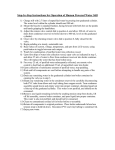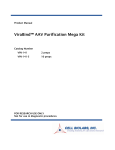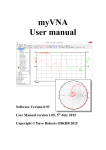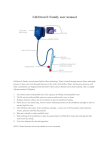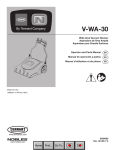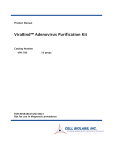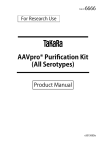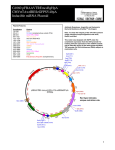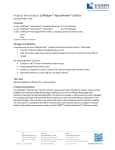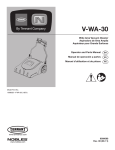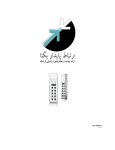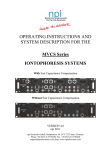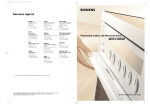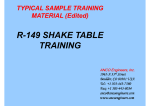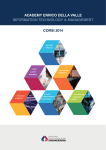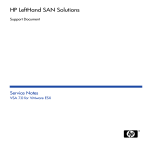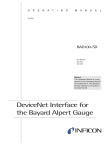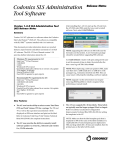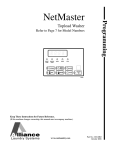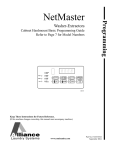Download QuickTiter™ AAV Quantitation Kit
Transcript
Product Manual QuickTiter™ AAV Quantitation Kit Catalog Number VPK-145 20 assays FOR RESEARCH USE ONLY Not for use in diagnostic procedures Introduction Viral gene delivery systems include vectors developed from retrovirus (RV), adenovirus (AdV), adeno-associated virus (AAV), lentivirus (LV), and herpes simplex virus (HSV). AAV belongs to the family of Parvoviridae, a group of viruses among the smallest of single-stranded and non-enveloped DNA viruses. There are eight different AAV serotypes reported to date. Recombinant AAV-2 is the most common serotype used in gene delivery, and it can be produced at high titers with a helper virus or Cell Biolabs’ AAV Helper-Free System. AAV-2 can infect both dividing and non-dividing cells and can be maintained in the human host cell, creating the potential for long-term gene transfer. Because AAV-2 is a naturally defective virus, requiring provision of several factors in trans configuration for productive infection, it is considered the safest viral vector to use. Recently a new vector, AAV-DJ, was developed using DNA family shuffling to create a hybrid capsid from 8 different AAV serotypes, resulting in a vector with significantly higher in vitro infection rates across a variety of cells and tissues. Recombinant AAV-2 and AAV-DJ vectors can be purified by CsCl gradient ultracentrifugation, iodixanol discontinuous gradient ultracentrifugation, or Cell Biolabs’ ViraBind™ AAV Purification Kit. A particular challenge in the delivery of a gene by a viral vector is the accurate measurement of virus titer. Traditionally, AAV particles are measured by DNA dot blot or similar approaches. These methods are time-consuming and suffer from a high degree of inter-assay variability. For highly purified virus samples, an optical absorbance at 260 nm has been used to estimate the total number of virus particles. However this method cannot be used in an unpurified viral supernatant, because other components it contains can contribute to the optical absorbance of 260 nm. An ELISA method has been developed by using antibody that only reacts with AAV intact particles; however, this method measures all AAV particles including the ones lacking genomic DNA. Cell Biolabs’ proprietary QuickTiter™ AAV Quantitation Kit does not involve cell infection; instead it specifically measures the viral nucleic acid content of purified viruses or unpurified viral supernatant sample (See Assay Principle). The kit is especially useful for determining the supernatant titer before the purification step. The kit has a detection sensitivity limit of 1 X 109 GC/mL (genome copy/mL) for unpurified AAV-2 or AAV-DJ supernatants, or 5 X 1010 GC/mL for purified AAV sample from any serotype, which is sufficient for mid or high-titer AAV samples. The entire procedure takes about 4 hours for unpurified supernatant or about 30 minutes for purified AAV. Each kit provides sufficient quantities to perform up to 20 tests for unpurified AAV-2 or AAV-DJ samples generated from the AAV Helper-Free System. QuickTiter™ AAV Quantitation Kit provides an efficient system for rapid quantitation of AAV titer for both viral supernatant and purified virus. 2 Assay Principle 3 Related Products 1. AAV-100: 293AAV Cell Line 2. VPK-140: ViraBind™ AAV Purification Kit 3. VPK-141: ViraBind™ AAV Purification Mega Kit 4. AAV-200: ViraDuctin™ AAV Transduction Kit 5. VPK-109: QuickTiter™ Adenovirus Titer Immunoassay Kit 6. VPK-110: QuickTiter™ Adenovirus Titer ELISA Kit 7. VPK-106: QuickTiter™ Adenovirus Quantitation Kit 8. VPK-112: QuickTiter™ Lentivirus Quantitation Kit 9. VPK-120: QuickTiter™ Retrovirus Quantitation Kit Kit Components 1. ViraBind™ AAV Reagent A (Part No. 314001): One 0.3 mL tube. 2. ViraBind™ AAV Reagent B (Part No. 314002): One 1.5 mL tube. 3. QuickTiter™ AAV Capture Matrix (Part No. 314501): One 1 mL tube. 4. QuickTiter™ AAV Wash Solution (5X) (Part No. 314502): One 10 mL bottle. 5. QuickTiter™ Solution C (10X) (Part No. 314503): One 5 mL bottle. 6. CyQuant® GR Dye (400X) (Part No. 105101): One 50 µL tube. 7. QuickTiter™ AAV DNA Standard (Part No. 314504): One 500 µL tube containing 100 µg/mL AAV DNA Standard. Materials Not Supplied 1. AAV Helper-Free System 2. HEK 293 cells and cell culture growth medium 3. Cell culture centrifuge 4. 1X TE (10 mM Tris, pH 7.5, 1 mM EDTA) 5. Fluorescence Plate Reader Storage Store ViraBind™ AAV Reagent B at room temperature and all other kit components at 4ºC until their expiration dates. 4 Safety Considerations Remember that you will be working with samples containing infectious virus. Follow the recommended NIH guidelines for all materials containing BSL-2 organisms. Preparation of Reagents 1X QuickTiter™ AAV Wash Solution: Prepare a 1X QuickTiter™ AAV Wash Solution by diluting the provided 5X stock 1:5 in deionized water. Store the diluted solution at room temperature. 1X QuickTiter™ Solution C: Prepare a 1X QuickTiter™ Solution C by diluting the provided 10X stock to 1X with 1X TE. Store the diluted solution at room temperature. 1X CyQuant® GR Dye: Estimate the amount of 1X CyQuant® GR Dye needed based on the number of assays including AAV DNA standard samples. Immediately before use, prepare a 1X CyQuant® GR Dye by diluting the provided 400X stock 1:400 in 1X TE. For best results, the diluted solution should be used within 2 hrs of its preparation. Preparation of Standard Curve 1. Create AAV DNA standards from 10 µg/mL, 5 µg/mL, 2.5 µg/mL, 1.25 µg/mL,… 0 µg/mL (using 1:2 serial dilutions). Standard Tubes 1 2 3 4 5 6 7 8 9 10 11 12 1X QuickTiter™ Solution C (µL) 90 50 50 50 50 50 50 50 50 50 50 50 100 μg/mL AAV DNA Standard (µL) 10 50 of Tube #1 50 of Tube #2 50 of Tube #3 50 of Tube #4 50 of Tube #5 50 of Tube #6 50 of Tube #7 50 of Tube #8 50 of Tube #9 50 of Tube #10 0 AAV DNA Standard (µg/mL) 10 5 2.5 1.25 0.625 0.313 0.156 0.078 0.039 0.020 0.010 0 2. Transfer 10 µL of each dilution including blank to a microtiter plate suitable for reading on a fluorometer. Add 90 µL of 1X CyQuant® GR Dye to each of the wells containing the 10 µL sample. Read the plate with a fluorescence plate reader using a 480/520 nm filter set. 5 Preparation of rAAV Samples The following procedure is suggested for one 15 cm dish or two 10 cm dishes and may be optimized to suit individual needs. For best results please refer to your user manual for Cell Biolabs’ AAV HelperFree System or other system you are using. In general, each cell produces about 20,000 to 100,000 viral particles under optimized conditions. 1. Use HEK 293 cells that have been passaged 2-3 times prior to transfection. Culture these cells until the monolayer is 70-80% confluent. 2. Cotransfect cells with the pAAV-RC, pHelper and your expression construct according to manufacturer’s manual. 3. After 48-72 hrs, harvest the transfected cells plus culture medium in a conical tube and centrifuge for 5 min at 3000 rpm to pellet the transfected cells. Resuspend the cell pellet in 2.5 mL of serum-free DMEM. 4. Subject the cell suspension to four rounds of freeze/thaw cycles by alternating the tubes between the dry ice-ethanol bath and the 37ºC water bath. 5. Collect the AAV supernatant by centrifugation at 10,000 x g for 10 minutes. Discard the pellet. 6. The viral supernatant can be stored at -80ºC or immediately titered or purified. Assay Protocol I. Unpurified AAV-2 or AAV-DJ Samples Note: The following procedure is written for quantitation of 1.0 mL of unpurified AAV-2 or AAV-DJ supernatant. For AAV samples that are less than 1.0 mL, add serum-free DMEM to the final volume of 1.0 mL. 1. Add 10 µL of ViraBind™ AAV Reagent A to 1.0 mL of viral supernatant, mixing well. 2. Incubate for 30 minutes at 37ºC. 3. Incubate ViraBind™ AAV Reagent B for 30-60 minutes at 37ºC to ensure Reagent B is dissolved. Add 50 µL of ViraBind™ AAV Reagent B to the viral supernatant pre-treated with ViraBind™ AAV Reagent A, mixing well. 4. Incubate for 30 minutes at 37ºC. 5. Resuspend the QuickTiter™ AAV Capture Matrix by inverting and shaking. Add 50 µL of matrix to the virus supernatant. 6. Mix the supernatant/matrix suspension at room temperature for 30 minutes on a shaker. 7. Pellet the AAV Capture Matrix by centrifugation for 10 minutes at 1,000 rpm. 8. Carefully remove the supernatant and wash the AAV Capture Matrix with 1.0 mL of 1X QuickTiter™ AAV Wash Solution. Pellet the AAV Capture Matrix by centrifugation for 5 minutes at 1,000 rpm and carefully remove the supernatant. 9. Repeat the wash step once and aspirate the final wash. To remove the last bit of liquid, centrifuge the tube again at 2000 rpm for 30 seconds, and remove remaining supernatant with a small bore pipette tip to avoid disturbing the beads. 6 10. Add 20 µL of 1X QuickTiter™ Solution C and mix with the beads by vortexing for 30 seconds. Incubate 1 hr at 75ºC. Spin down the beads at 12,000 rpm for 30 seconds. 11. Transfer 10 µL supernatant to a microtiter plate suitable for fluorometer. Add 90 µL of freshly prepared 1X CyQuant® GR Dye to well(s) containing the 10 µL supernatant. Read the plate with a fluorescence plate reader using a 480/520 nm filter set. 12. Calculate AAV titer based on the standard curve. II. Purified AAV Sample 1. Mix 13.5 µL of purified AAV sample and 1.5 µL of 10X QuickTiter™ Solution C in a tube and incubate 1 hr at 75ºC. Spin briefly to collect condensation. Incubate 20 minutes at room temperature. 2. Prepare a non-heated control sample by mixing 13.5 µL of the same purified AAV sample and 1.5 µL of 10X QuickTiter™ Solution C in a tube. 3. Transfer 10 µL of the mixtures including the non-heated control sample to a microtiter plate suitable for reading in a fluorometer. Add 90 µL of freshly prepared 1X CyQuant® GR Dye to each well containing the 10 µL supernatant. Read the plate with a fluorescence plate reader using a 480/520 nm filter set. 4. Calculate AAV titer based on the standard curve. Example of Results The following figures demonstrate typical quantitation results. One should use the data below for reference only. This data should not be used to interpret actual results. 20 200 175 15 150 RFU RFU 125 100 10 75 5 50 25 0 0 0 25 50 75 100 125 0 150 2 4 6 8 10 AAV DNA STD (ng) AAV DNA STD (ng) Figure 1: AAV-2 DNA Standard Curve. The QuickTiter™ AAV-2 DNA Standard was diluted as described in the Assay Protocol. Fluorescence measurement was performed on a SpectraMax Gemini XS Fluorometer (Molecular Devices) with a 485/538 nm filter set and 530 nm cutoff. 7 Calculation of AAV-2 Titer (Genome Copy (GC)/mL) 1. Determine AAV-2 DNA amount: 1) Calculate Net RFU (Relative Fluorescence Unit): Net RFU = RFU (viral sample) – RFU (negative control corresponding to viral sample) 2) Use the standard curve to determine the viral DNA amount of each unknown sample. 2. Calculate Viral Titer: The average genome size of an AAV-2 is 5000 base, therefore: 1 ng AAV-2 DNA = (1x10-9) g / (5000 base x 330 g/base) X 6 x 1023 = 3.6 x 108 GC (a) For unpurified AAV-2 sample: Net RFU = RFU (viral sample) – RFU (0 ng/mL standard) Titer (GC/mL) = Dilution Factor X AAV-2 DNA (ng) X (3.6 x 108 GC/ng) X (20 µL/10 µL) 1.0 mL (b) For purified AAV-2 sample: Net RFU = RFU (viral sample) – RFU (non-heated control sample) Titer (GC/mL) = Dilution Factor X AAV-2 DNA (ng) X (3.6 x 108 GC/ng) X (15 µL/13.5 µL) 0.010 mL Calculation Example Purified AAV-2-GFP (ViraBind™ AAV Purification Kit): undiluted purified AAV-2-GFP was used as described in Assay Protocol Net RFU = 54.6 – 3.3 = 51.3 or 28 ng of viral DNA Titer (GC/mL) = Dilution Factor X AAV-2 DNA (ng) X (3.6 x 108 GC/ng) X (15 µL/13.5 µL) 0.010 mL Titer (GC/mL) = 1 X 28 (ng) X (3.6 x 108 GC/ng) X (15 µL/13.5 µL) = 1.12 X 1012 GC/mL 0.010 mL References 1. Rabinowitz, J, and Samulski, R. J. (1998) Curr. Opin. Biotechnol., 9, 470-475. 2. Summer ford, C., and Samulski, R. J. (1999) Nat. Med., 5, 587-588. 3. Clark, K., Liu, X., McGrath, J., and Johnson, P. (1999) Hum. Gene Ther., 10, 1031-1039. Recent Product Citations 1. Orabi, A. I. et al. (2015). Dynamic imaging of pancreatic NF-κB activation in live mice using AAV infusion and bioluminescence. J Biol Chem. doi:10.1074/jbc.M115.647933. 2. Oh, S. M. et al. (2015). Combined Nurr1 and Foxa2 roles in the therapy of Parkinson's disease. EMBO Mol Med. doi: 10.15252/emmm.201404610. 8 3. Stankowska, D. L. et al. (2015). Neuroprotective effects of transcription factor Brn3b in an ocular hypertension rat model of glaucoma. Invest Ophthalmol Vis Sci. 56:893-907. 4. Li, Y. et al. (2014). Assembly and validation of versatile transcription activator-like effector libraries. Sci Rep. 4:4857. 5. Paydar, A. et al. (2014). Extrasynaptic GABAA receptors in mediodorsal thalamic nucleus modulate fear extinction learning. Mol Brain. 7:39. 6. Vinnikov, I. A. et al. (2014). Hypothalamic miR-103 protects from hyperphagic obesity in mice. J Neurosci. 34:10659-10674. 7. Ma, J. et al. (2013). RNA interference-mediated silencing of Atp6i prevents both periapical bone erosion and inflammation in the mouse model of endodontic disease. Infect. Immun. 81:1021-1030. 8. Tao, P. et al. (2013). In vitro and in vivo delivery of genes and proteins using the bacteriophage T4 DNA packaging machine. PNAS. 10.1073/pnas.1300867110. License Information This product is provided under an intellectual property license from Life Technologies Corporation. The purchase of this product conveys to the buyer the non-transferable right to use the purchased product and components of the product only in research conducted by the buyer (whether the buyer is an academic or for-profit entity). The sale of this product is expressly conditioned on the buyer not using the product or its components, or any materials made using the product or its components, in any activity to generate revenue, which may include, but is not limited to use of the product or its components: (i) in manufacturing; (ii) to provide a service, information, or data in return for payment; (iii) for therapeutic, diagnostic or prophylactic purposes; or (iv) for resale, regardless of whether they are resold for use in research. For information on purchasing a license to this product for purposes other than as described above, contact Life Technologies Corporation, 5791 Van Allen Way, Carlsbad CA 92008 USA or [email protected]. Warranty These products are warranted to perform as described in their labeling and in Cell Biolabs literature when used in accordance with their instructions. THERE ARE NO WARRANTIES THAT EXTEND BEYOND THIS EXPRESSED WARRANTY AND CELL BIOLABS DISCLAIMS ANY IMPLIED WARRANTY OF MERCHANTABILITY OR WARRANTY OF FITNESS FOR PARTICULAR PURPOSE. CELL BIOLABS’ sole obligation and purchaser’s exclusive remedy for breach of this warranty shall be, at the option of CELL BIOLABS, to repair or replace the products. In no event shall CELL BIOLABS be liable for any proximate, incidental or consequential damages in connection with the products. Contact Information Cell Biolabs, Inc. 7758 Arjons Drive San Diego, CA 92126 Worldwide: +1 858-271-6500 USA Toll-Free: 1-888-CBL-0505 E-mail: [email protected] www.cellbiolabs.com 2008-2015: Cell Biolabs, Inc. - All rights reserved. No part of these works may be reproduced in any form without permissions in writing. 9









